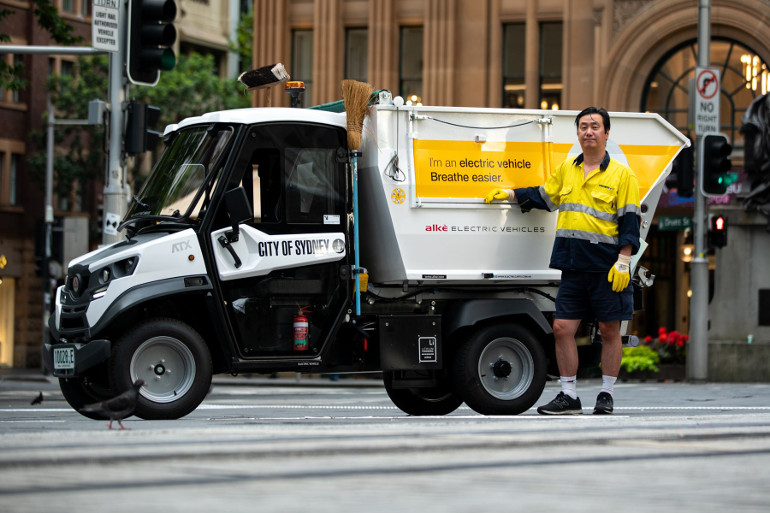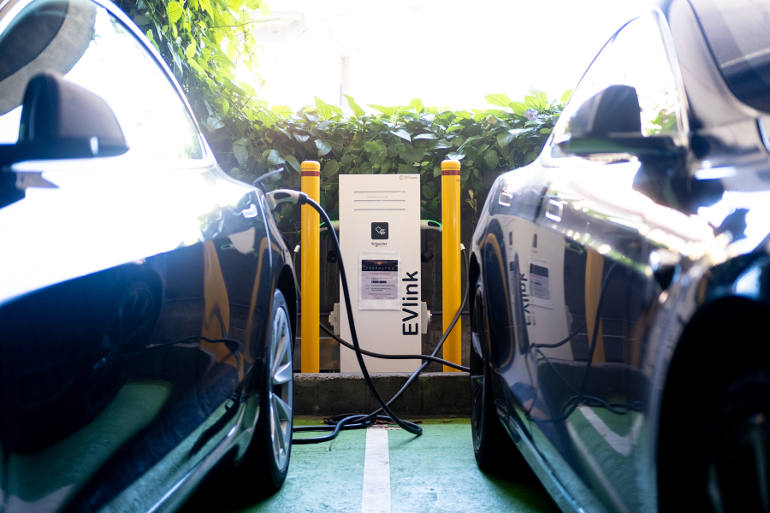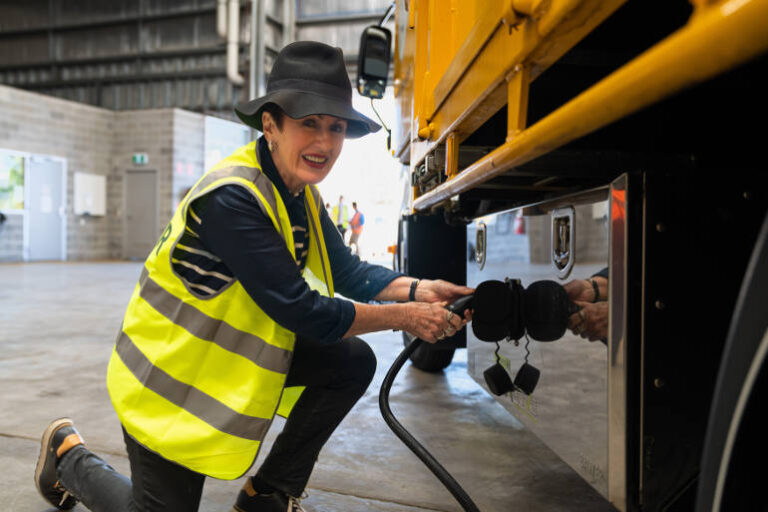Doubling electric vehicle chargers in our car parks, trialling low-impact on-street charging and a comprehensive research project to help retrofit existing buildings with chargers are among the first actions in the City of Sydney’s new electric vehicle strategy.
The draft Electrification of Transport in the City Strategy and Action Plan, passed unanimously for public exhibition by the City Council in February, outlines City plans to electrify transport fleets and lower the barriers to electric vehicle use in our local area.
Key actions arising from the new plan:
- Accelerating the transition of the City’s own light and heavy vehicle fleet
- Increasing capacity of our depots to handle more and bigger electric vehicles
- Encouraging public rapid charging facilities in car parks and service stations
- Increasing the capacity and number of electric chargers in City-controlled car parks
- Working with Ausgrid to trial low-impact on-street charging in locations without off-street options
- Updating planning controls to encourage and support charging capacity in new buildings
- Conducting a comprehensive research project to understand the challenges and opportunities of retrofitting existing apartment buildings with chargers

Lord Mayor Clover Moore said reducing private vehicle dependence while supporting the electrification of vehicles would help lower transport emissions and reach the City’s net zero targets.
“If we are to stop dangerous runaway climate change, we need to reach net zero emissions as soon as possible. Lowering transport emissions, which are currently around 20% of all our emissions, will be crucial to this task,” the Lord Mayor said.
“Reducing private vehicle dependence is the most effective way to cut emissions, so we remain focused on delivering our comprehensive bike network, supporting ambitious public transport projects and ensuring our city is a pleasant and accessible place to walk to, from and around.
“Not all trips can be completed on a bike or public transport so electrification of high-impact fleets such as delivery and service vehicles, as well as private vehicles, will help complete the journey to net zero transport.”
Under the new plan, the City will increase capacity in Goulburn Street and Kings Cross car parks to 18 chargers, with another two 22kWh chargers to be installed in Cope Street car park in Redfern and Wilson Street car park in Newtown.
The City of Sydney is also working with Ausgrid to test an unobtrusive on-street electric vehicle charger on an existing power pole in Glebe to explore ways to support on-street charging access without burdening the public domain.
Modelling and technical analysis that underpins the plan shows around 20% of emissions in our area come from transport, and the biggest barriers to using electric vehicles are affordability, availability and access to charging.
The local area already has more than 100 publicly available charging points and research indicates most people will charge their vehicles in buildings, garages and depots.
The City of Sydney will work with providers to get more chargers where they’re needed, predominantly in off-street car parks, service stations and some street locations, balancing the need to protect footpaths and public spaces.
As part of the strategy, the City of Sydney will use its planning controls to make sure all new developments are electric vehicle ready.
Over the coming months, the City of Sydney will investigate the technical, governance and management challenges our strata communities face as they start to address increasing demand to retrofit apartment buildings with EV charging.
“In the city context, where over 75% of people live in apartments, strata charging presents a real opportunity to make a significant dent in our charging needs, but it’s complicated,” the Lord Mayor said.
“Many of these apartments have off-street parking spaces and we know that most of them will look to charge their electric vehicles in those spaces. The more who can, the less spillover there will be into other charging systems. But owners corporations need to juggle complex metering, demand management and efficiency, safety standards and insurance and of course, questions over who pays and how.
“We will be conducting a comprehensive research project in a range of different building styles and ages, to figure out how to overcome these challenges and outline best practice options for apartment buildings looking to retrofit.”
The City of Sydney will also advocate and support the state and federal government to encourage a faster uptake of electric vehicles in the private and commercial sectors through federal fuel efficiency standards, accelerating roll-out of zero emission buses, and pricing mechanisms that favour electric vehicles over internal combustion engines and subsidies that favour e-bikes over vehicles.
The City was one of the first organisations in Australia to start converting its fleet, procuring its first electric vehicle in 2010. Today the City’s fleet features 19 vehicles and 1 truck that are fully electric, and 73 hybrid cars and trucks. The City acquired its first electric truck in 2021 as a trial, a diesel truck which was converted to electric.
Under the new plan, the City of Sydney will accelerate transition to electric in its fleet and favour contractors with green fleets in procurement processes.
Research shows more than one third of local residents don’t own a car. Based on current trends, the rates of ownership are predicted to rise by 8 per cent by 2035, despite a 44 per cent rise in the number of dwellings.
“We hope that by 2035 all vehicles in our area are electric. This is a sector that is evolving quickly, and we want to make sure that we remove any possible barrier to our residents getting an electric vehicle or better still, changing their commute for a bus or train, an e-bike or choosing to walk,” the Lord Mayor said.
“The state government has committed to installing 500 electric vehicle charging bays across NSW over the next two years, with a few in the first round being installed in our area. We will encourage and support this continued investment in the future.
“We don’t currently have a role in fuelling vehicles but to support the transition to electrification, we will step in. While the private sector ramps-up its charging initiatives, we will work with service providers to ensure that charging is available in areas with limited off-street charging opportunities. This includes the additional charging infrastructure we are installing in City of Sydney-owned car parks and the trial of low impact on-street charging.
“We are also conscious that when residents and fleet operators charge their electric vehicles, they do it using renewable electricity, or GreenPower, which is a great option for renters and helps promote more renewable energy generation.”







